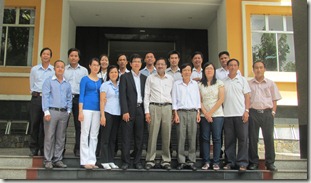Building cross border fruit and vegetable value chains in developing countries for enhancing export performance, particularly exports to developed countries.
Vietnam campus of the ‘Asian Institute of Technology’ in Ho Chi Min City (HCMC) () has successfully organized a 3-day training course recently on “International Trade Environment of Fruit and Vegetables – one of the potential export products categories of Vietnam”.
I facilitated and conducted the training with marvelous support from an interpreter and translator in Mr. Khang Nguyen, who not only interpreted and translated my spoken and written words, but also mimicked my newly found trainers’ enthusiasm and body language.
It would be pertinent to add here that it was only because of commendable efforts and tenacity of Ms Nhien, who contacted me in a faraway country, I had this opportunity to visit Vietnam, a beautiful country, share my trade experiences with witty professionals and best of all, make friends with many lively Vietnamese folks. I can’t thank you more Ms. Nhien.
The training course was conducted by young Ms Nguyen Phuong Thao with such a élan, that is worthy only of a seasoned professional who has seen scores of seasons going through similar training routines. Keep it up Ms. Thao!
(Ms. Thao and Mr. Nguyen, you made my days in Saigon. If it were not you, I would have been completely lost in a communication vacuum. Thanks for your excellent support. The World is language neutral because of people like you.
 Coming back to event in context – AIT’s course content addressed the need to assist enterprises, governmental agencies and industry associations to build up capacity of their high level staff that included company directors, senior and middle management, officers and experts who work in the field of cross border trading, exports and promotion of fruit and vegetable products.
Coming back to event in context – AIT’s course content addressed the need to assist enterprises, governmental agencies and industry associations to build up capacity of their high level staff that included company directors, senior and middle management, officers and experts who work in the field of cross border trading, exports and promotion of fruit and vegetable products.
Looking at the composition of participants, their familiarity with the subject and their diverse training needs, I intentionally choose the middle path by starting with a broad overview of International Fruit and Vegetable trade, followed by granular view of Vietnam’s fresh produce exports that culminated in identifying Japan as the most promising and potential trade partner. Whole workshop was interspersed with case studies, assignments, group discussions, QA sessions, video presentations etc. – all excellently transferred to participants by Nugyen.
While recognizing that rebuilding of export oriented value chain shall be imperative if Vietnam wants to turnaround its export performance for a developed country like Japan, a mythical value chain turnaround plan was hurriedly build and presented to the participants to apprise them of various steps needed for project identification, capacity building, formulation and design for such a plan. The training course culminated with small teams of 4 members each developing and presenting their own fictitious fruit and vegetable export oriented projects, like initiation of dragon fruit export from Vietnam to Middle East.
In retrospect I may add that the cross-border value chains, especially the chains that include many partners and stakeholders from developing and developed countries, are rather complex since many differences in social, technological and commercial aspects exist between these partners that influence the success of a supply chain. Trust and commitment and a will to survive and succeed are crucial elements to achieve partnerships, chain integration and chain optimization. Because of the different trade environments in which cross-border supply chains operate, chain partners have to deal with several trade rules, regulations and laws, a large logistic network, different levels of technologies, etc. Awareness and knowledge of each other’s ground situation and building / executing action plans is a very important.
Last thoughts…
In less than four days we could talk only of few strategic steps for streamlining fruit and vegetable supply chain in Vietnam. Time was too short to build plethora of strategic options and execute any strategy. A strategy does not mean anything unless executed and executed well which in turns depends upon people and operations, the detailed action plans. The heart of the working of a business, Vietnamese exporters no exception, is how the three processes of people, strategy, and operations link together. Businesses have to master the individual processes and the way they work together as a whole. They are the foundation for the discipline of execution, at the center of conceiving and executing a strategy. They are the differentiation between Vietnamese exporters (or exporters / businessmen from any other country) and its competitors and its closeness to its customers.
Considering many requests from participants and sponsors I am posting here few of the select presentations I made at the event.



